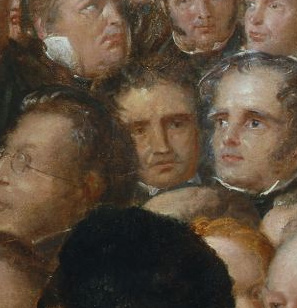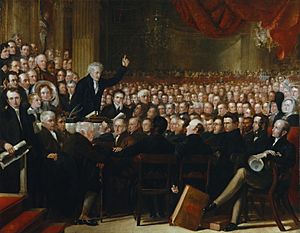Charles Stuart (abolitionist) facts for kids
Quick facts for kids
Captain Charles Stuart
|
|
|---|---|

Capt. Stuart between Thomas Scales (left) and Sir John Jeremie (right) shown in a detail from The Anti-Slavery Society Convention, 1840, by Benjamin Robert Haydon
|
|
| Born | 1783 |
| Died | 1865 |
| Education | Belfast |
| Known for | Abolitionist |
Captain Charles Stuart (1783 – 26 May 1865) was an important person who worked to end slavery. He was an abolitionist from Britain and Canada. After leaving the army, he spent his life writing. His main goal was to help stop slavery around the world.
Contents
His Life Story
Where Charles Stuart Grew Up
Charles Stuart was born in 1783. He was born in Bermuda, an island in the Atlantic Ocean. Some old records said he was born in Jamaica. But Canadian records show he was definitely from Bermuda.
His father was likely an officer in the British Army. Charles Stuart later went to school in Belfast, a city in Northern Ireland.
From Soldier to Activist
Charles Stuart first chose a career in the military. He left the army in 1815. In 1817, he moved to Upper Canada. This area is now part of Ontario, Canada.
He settled in a town called Amherstburg. There, he started helping Black refugees. These were people who had escaped slavery in the United States. He helped them begin new lives as farmers. He even started a small community for them near Amherstburg.
In 1822, Stuart took a job in New York State. He became the principal of Utica Academy. While there, he met a young man named Theodore Dwight Weld. Weld later became a major leader in the American abolitionist movement. This movement worked to end slavery in the United States.
By 1829, Charles Stuart returned to England for a while. During this time, he wrote many powerful pamphlets. These writings helped to influence people against slavery.
Fighting for Freedom at the World Convention
In June 1840, Charles Stuart attended the World Anti-Slavery Convention. This was a big meeting in London, England. People from all over the world came together to discuss how to end slavery.
A famous artist named Benjamin Haydon painted a picture of the event. It showed 130 of the most important people there. Charles Stuart is in this painting. You can see it at the National Portrait Gallery in London.
Retirement and His Beliefs
Charles Stuart retired in 1850. He moved to a farm near Thornbury, Ontario. It was located at Lora Bay on Georgian Bay. He strongly believed in his cause. In his home, he did not allow any product that was made using slave labour.
His Important Writings
Charles Stuart wrote several important works. These writings helped to spread his anti-slavery message.
- The emigrant's guide to Upper Canada; or, sketches of the present state of that province, collected from a residence therein during the years 1817, 1818, 1819, interspersed with reflections (London, 1820)
- The American colonization scheme further unravelled, undated, but reviewed at length in The Liberator of April 19, 1834.


